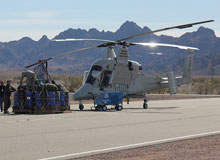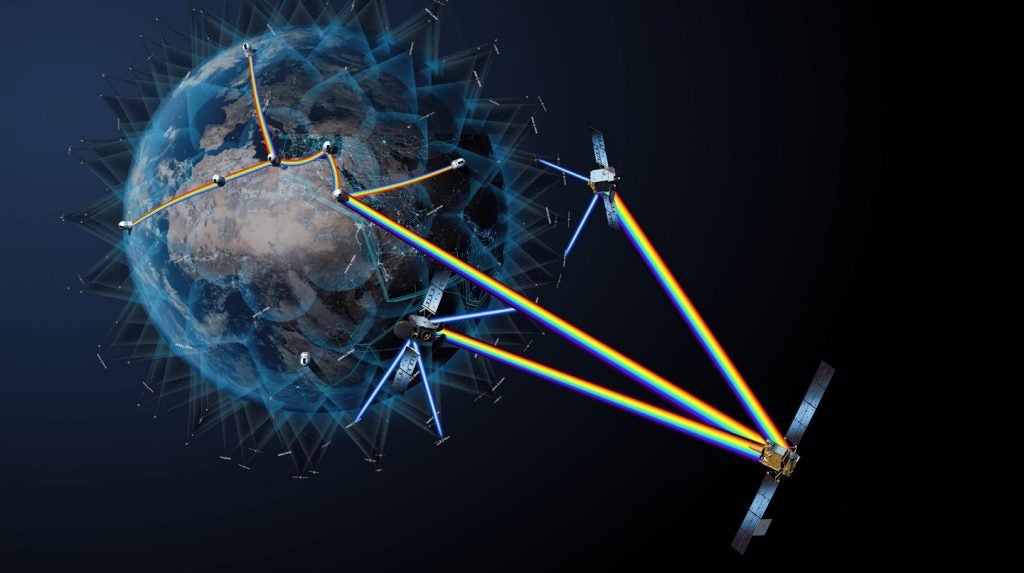
Transformational technologies are innovations that enable a challenge to be addressed in a game-changing way. One such challenge is transporting fuel and other supplies to remote frontline operations in theatres of war such as Afghanistan over an inhospitable landscape littered with IEDs.
The other major challenge is power supply. To achieve the mission criteria of reducing the logistics burden, UAVs need to be power-friendly, i.e. they shouldn’t require a large power infrastructure that needs to be guarded or transported over dangerous territory.
Two recent breakthroughs in UAV technology aim to address this. The K-MAX unmanned helicopter aims to autonomously deliver heavy loads to the front line without risking the lives of a crew; and the laser propulsion system developed by LaserMotive could enable UAVs to stay aloft indefinitely by powering them remotely.
K-MAX unmanned helicopter
One essential aspect of UAVs is that they are used where it would be too dangerous to send a manned aircraft. A new programme is looking to use an autonomous helicopter for one of the most risky operations facing frontline personnel – resupplying forward operating bases.
The K-MAX unmanned helicopter is a programme led by Lockheed Martin, working alongside heavy lifting helicopter specialist Kaman Aerospace.
The companies struck a strategic relationship in 2007 to develop an unmanned version of a Kaman helicopter with an autonomous capability, with Lockheed providing the mission management and ground system capability and Kaman providing the helicopter.
How well do you really know your competitors?
Access the most comprehensive Company Profiles on the market, powered by GlobalData. Save hours of research. Gain competitive edge.

Thank you!
Your download email will arrive shortly
Not ready to buy yet? Download a free sample
We are confident about the unique quality of our Company Profiles. However, we want you to make the most beneficial decision for your business, so we offer a free sample that you can download by submitting the below form
By GlobalDataJim Naylor, Director for Business Development for the K-MAX Programme at Lockheed Martin, says: “We chose to get involved this because if we could provide an unmanned logistic resupply capability [in Afghanistan] we could save soldiers’ lives by taking trucks off the road. If we could deliver the supplies via the unmanned air capability instead that would take soldiers out of harm’s way from IEDs.”
Naylor adds that Lockheed selected Kaman’s K-MAX platform because it is purpose-built to carry out lift-type missions. At 6,000lbs, it can carry its own weight under normal operational parameters, and is a low-maintenance craft that economical to run and service.
At the end of 2010, the companies successfully demonstrated K-MAX to the US Marine Corps at the Dugway Proving Ground in Utah against a number of Navy objectives and threshold criteria.
Terry Fogarty, general manager for the UAS product group at Kaman Aerospace, explains that there are a number of challenges having software replace all the tasks a pilot performs.
“K-MAX is an adapted piloted aircraft, so we were able to do 99% of our testing with a pilot in the cockpit acting as a safety and technical observer, witnessing first hand how responsive this software was,” says Fogarty.
In December 2010, US Navy Systems Command awarded the companies a $45.8m contract to supply two aircraft and three remote control ground stations for a quick reaction assessment that will take place in summer 2011.
“If that is successful, we will have the opportunity to field the K-MAX platform in theatre for a six-month assessment and operate it as an unmanned logistics resupply capability,” says Naylor.
Laser-powered UAVs
Other than some solar-powered high altitude persistent models currently under development, UAVs have to return to earth to have their batteries recharges or fuel cells filled. LaserMotive has developed economically viable technology to use lasers to remotely power motors and recharge batteries while UAVs are flying.
Company President Tom Nugent founded LaserMotive in 2006 with Dr Jordin Kare, a researcher with 25 years experience in laser power beaming. The company first came to the public’s attention when it won a NASA sponsored challenge for its laser-powered cable climber that could be used in a future space elevator.
“UAVs made a great first practical application because there was a very strong demand for increasing their endurance,” says Nugent. “There are fundamental limits to what you can get from a battery or fuel cell. Laser power is in a sense an extension cord from the ground to the air to constantly refuel the UAV without any physical connection.”
The concept works by taking electricity from the grid or a generator and turning it into laser light which is beamed to a remote receiver on the UAV, much like a solar cell. This converts the light back into electricity where it can be used to drive a motor or power a battery or payload. LaserMotive uses near-infrared diode lasers because they offer the best efficiency and lowest cost per unit power.
Nugent says the technology can be used on a range of UAV platforms. “We demonstrated it last October flying it on the small Quadrocopter made by Ascending Technologies. It can be applied to helicopters, airplanes or air ships and aerostats, and we are currently in discussion with a couple of groups about partnering to apply to specific UAVs.”
The technology is not limited by the size of the UAV as larger aircraft can host a larger receiver to generate more power. According to Nugent the power to weight ratio only needs to be only slightly better than the equivalent battery it replaces, though a battery backup needs to remain. So far, the longest flight for a laser powered Quadrocopter was 12.5 hours, which only stopped because of limitations at the test site.
The laser is kept centred on the receiver using parallel machine vision. If the beam breaks, the UAV temporarily switches to the backup battery until the connection can be re-established, a technique LaserMotive calls asynchronous energy delivery.
Nugent adds that the biggest challenges facing LaserMotive’s UAV solution are regulatory.
“We are developing a fully-integrated safety system so that the beam can shut off if anything were to fly into it, whether it’s another aeroplane or a bird,” he says. “We expect it will take a bit of discussion and repeated demonstrations with regulatory agencies for them to approve laser powered UAVs.”
According to Nugent, the remote laser power technology has a range of other military applications. These include powering a permanent atmospheric satellite for observation and communication over a base; or a UAV powered from a vehicle-mounted laser could fly ahead of a convoy providing protective surveillance. Alternatively, a fleet of UAVs could provide permanent surveillance beyond line of sight with one at a time returning to be charged while the others remain on duty.






